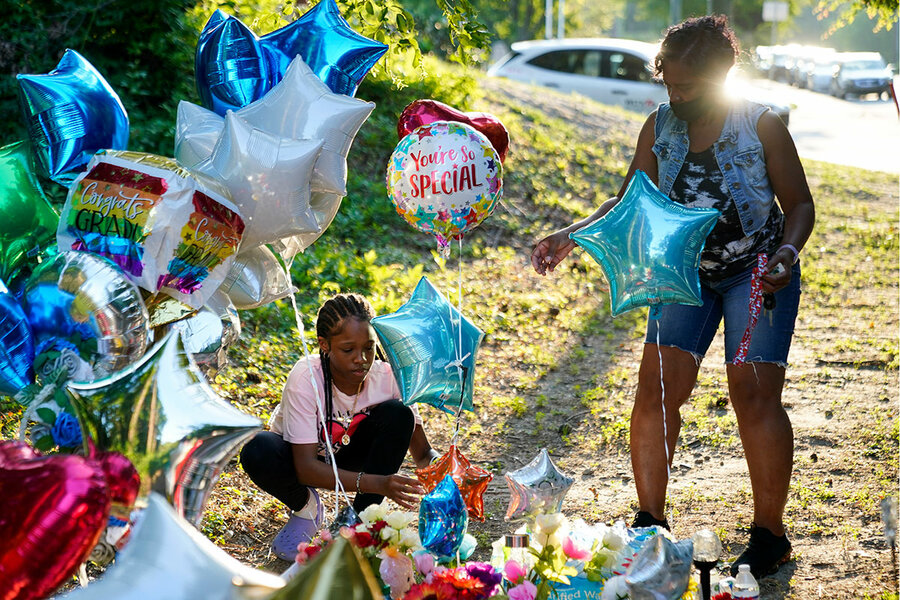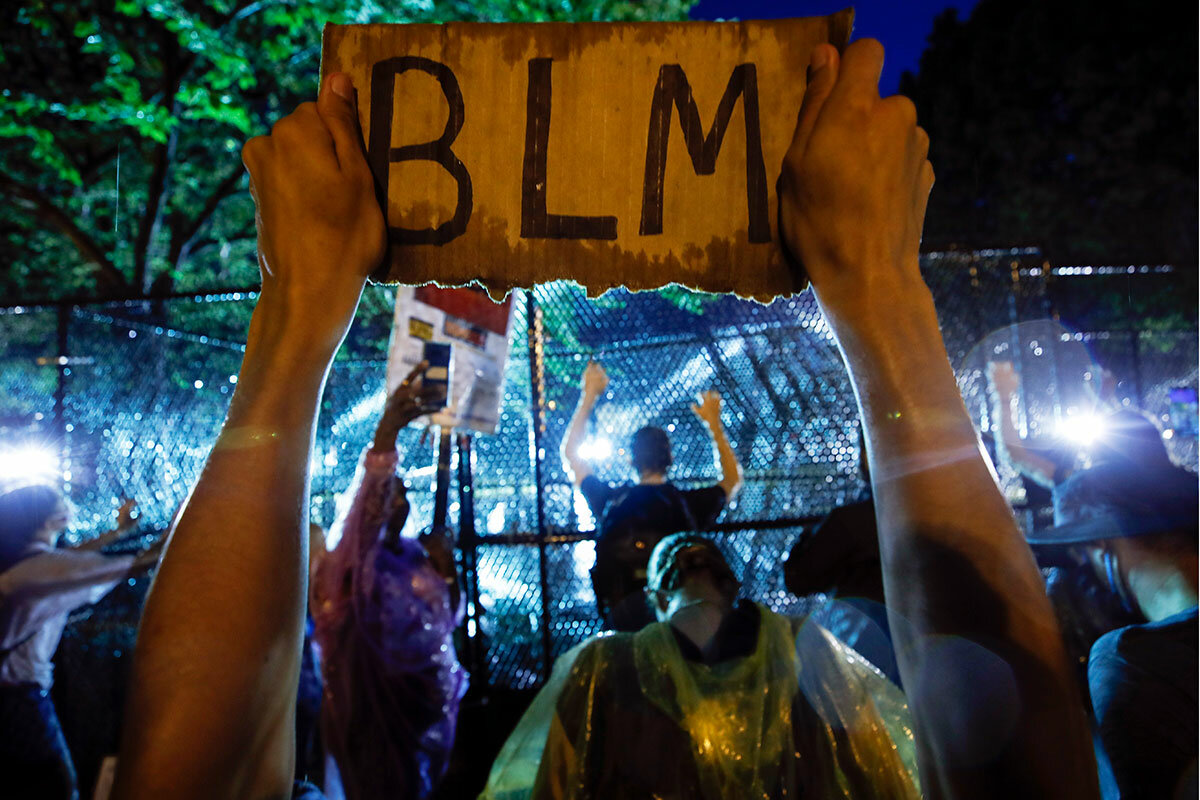Black lives lost, and the ‘language of the unheard’
Loading...
I never thought I would see something so profoundly remind me of the 1992 Los Angeles riots as the incident a few weeks ago about an hour’s drive from my home.
Cyrus Carmack-Belton, a 14-year-old Black middle schooler, was chased and fatally shot by a convenience store owner in Columbia, South Carolina, according to a police investigation resulting in a murder charge. While the store owner accused him of shoplifting, video footage indicates that he picked up a few bottles of water and then put them down.
Why We Wrote This
A story focused onThe killing of a Black middle schooler for no apparent reason reminds our contributor of too many similar losses. What could prove that Black lives matter?
The incident – and shoplifting allegations – immediately reminded me of Latasha Harlins, a 15-year-old Black girl who was killed in 1991 over a bottle of orange juice at a convenience store in South Central Los Angeles. Latasha’s death was one of the powder kegs, in addition to the 1992 acquittal of the police officers who beat Rodney King, that set off the LA riots. From South Central to South Carolina, history keeps repeating itself.
Black liberation has been met time and time again with slave patrols, police, water hoses – anything oppression can muster.
But Martin Luther King Jr. didn’t advocate meeting violence with violence. Roughly a year before his assassination, in a speech at Stanford University, he called for mass action.
He saw equality as the goal, with all hands on deck needed to achieve it.
If not, sadly, history will repeat itself.
Over the years, many have noted the effect of historical ignorance. Here’s one such comment, attributed to 18th-century British philosopher Edmund Burke: “Those who don’t know history are doomed to repeat it.”
That may be true, but knowing what happened in the past doesn’t protect us from repeating it.
I never thought I would see something so profoundly remind me of the 1992 Los Angeles riots as the incident a few weeks ago about an hour’s drive from my home.
Why We Wrote This
A story focused onThe killing of a Black middle schooler for no apparent reason reminds our contributor of too many similar losses. What could prove that Black lives matter?
Cyrus Carmack-Belton, a 14-year-old Black middle schooler, was chased and fatally shot by a convenience store owner in Columbia, South Carolina, according to a police investigation resulting in a murder charge. While the store owner accused him of shoplifting, video footage indicates that he picked up a few bottles of water and then put them down.
The incident – and shoplifting allegations – immediately reminded me of Latasha Harlins, a 15-year-old Black girl who was killed in 1991 over a bottle of orange juice at a convenience store in South Central Los Angeles. Latasha’s death was one of the powder kegs, in addition to the 1992 acquittal of the police officers who beat Rodney King, that set off the LA riots. From South Central to South Carolina, history keeps repeating itself.
I looked at young Cyrus’ face, and albeit in different circumstances, I saw the smile of 12-year-old Tamir Rice, whom police shot and killed. I thought about 16-year-old Ralph Yarl, shot by a stranger when he showed up at the man’s house by mistake, and 11-year-old Aderrien Murray, shot by police last month after he called 911 at his mother’s request.
These incidents are the rejection of basic calls for humanity and decency. It is the reason that Black Lives Matter remains relevant, in spite of criticisms of the national organization and questions about whether the summer of discontent after George Floyd’s murder in 2020 was a moment or a movement.
Black Lives Matter prevails as more than a hot summer or a culmination of protest arising from George Zimmerman’s killing of Trayvon Martin in 2012. It is an idea as old as race itself, a necessary response to and rebuke of the suggestion that being Black is synonymous with second-class citizenship.
Almost three years prior to the date Cyrus was killed, I participated in a Black Lives Matter protest in Columbia. People marched through the downtown area and ended up in front of a police station, which officers in riot gear promptly surrounded. At first, only words caromed off police shields, and then, presumably a water bottle.
That water bottle lit a fire in the officers, which led to a rushed panic among police and protesters alike. When the proverbial smoke had cleared, and I watched the news that evening back at home, a tank trudging through the street represented the local government’s militaristic response.
That angst is a function of history repeating itself. Columbia isn’t just South Carolina’s capital. It was a major center of the Confederacy and of post-Civil War Reconstruction. Columbia was the site of the first 1860 Southern secession convention, and less than eight years later, hosted the first Black-majority legislature. The political and periodically violent tug of war continues to this day, as Democrats plan to start the presidential primary cycle in South Carolina even as Republicans hold a legislative supermajority in the state.
Perhaps the gains of Black Lives Matter aren’t as profound as those of the Civil Rights Movement. There is a simple explanation for that: Black Lives Matter has become “the language of the unheard.” That phrase is best known from Martin Luther King Jr.’s 1967 “The Other America” speech at Stanford University, where he described riots as the language of the unheard.
That failure to hear – or listen – persists. I only need to reference the Atlanta City Council’s multimillion-dollar approval of what some term Cop City, a proposed police training facility still in the works despite 14 to 15 hours of public comment in overwhelming opposition. Protests against it have been an exercise in people versus policing, with notable incidents including the shooting death of an activist by police, and the arrest of bail fund organizers from the Atlanta Solidarity Fund.
It is history repeating itself.
Black liberation, much less the very notion of integration, has been met time and time again with slave patrols, police, water hoses – anything oppression can muster. It has become such a part of Americana that folks from convenience store owners to the likes of George Zimmerman deem themselves judge, jury, and executioner. A country in the midst of a pandemic chose to move money from COVID-19 relief to policing at the behest of President Joe Biden, who considers himself an ally of Black Americans.
As I watch Black lives and dreams continue to be deferred, I think of the warning from one of Harlem’s great Renaissance men, Langston Hughes:
Negroes,
Sweet and docile,
Meek, humble, and kind:
Beware the day
They change their mind!
Wind
In the cotton fields,
Gentle breeze:
Beware the hour
It uproots trees!
For King, though, a violent storm wasn’t the best route to progress. Not quite a year before he was assassinated, in the same speech at Stanford where he defined riots, he lamented “the other America” with its “blasted hopes and shattered dreams.” More importantly, he called for mass action to deal with the “triple evils” of racism, poverty, and war.
Action is the thing. Efforts to thwart activism are, by design, “winters of delay,” as King put it. He saw equality as the goal, with all hands on deck needed to achieve it.
If not, sadly, history will repeat itself.









